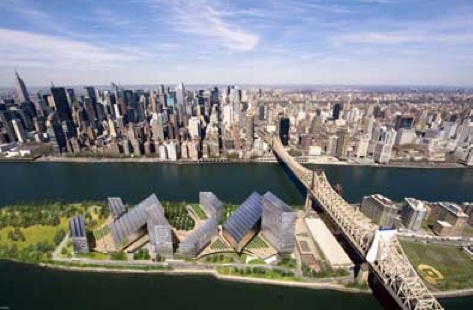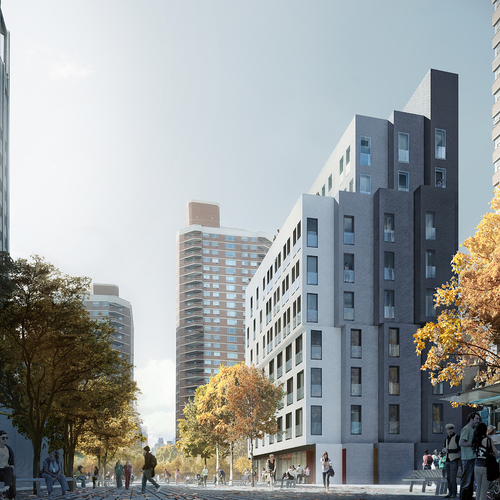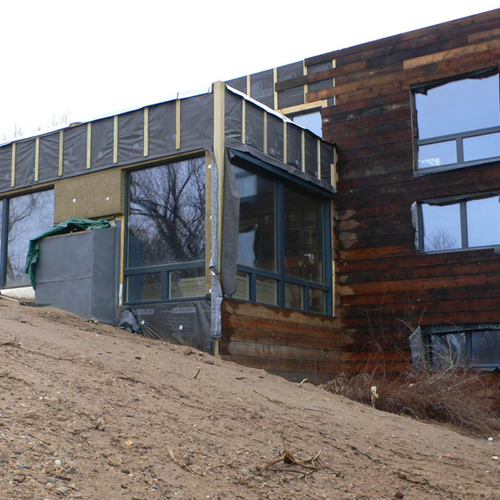Image Credit: Illustration by Cornell University / photo by Getty Images (image 1), Cornell University (images 2 and 3)
Image Credit: Illustration by Cornell University / photo by Getty Images (image 1), Cornell University (images 2 and 3) The Tech Campus main academic building is designed to offer 150,000 sq. ft. of interior space and operate at net zero energy. The proposed campus will sit just south of the Queensboro Bridge, which crosses Roosevelt Island at East 59th Street.
Roosevelt Island is technically part of the borough of Manhattan, but it has a distinct identity. Some of that has to do with its 19th-century history, when it was home to a lockup for convicts and institutions such as the Smallpox Hospital and New York City Lunatic Asylum.
But in contemporary life, that identity is more about the island’s spectacular location on the East River, between Manhattan and Queens, its status as a residential community of about 13,000 people, and, more recently, as the potential home of Cornell University’s New York City Tech Campus, a 10-acre project that would include a 150,000-sq.-ft. core academic building designed and built to perform at net zero energy. Cornell is bidding against proposals being presented to the city by Columbia University, New York University, and Stanford University for the contract to build a tech campus in town, with, in Columbia’s case, an extension in nearby Westchester County. (Mayor Michael Bloomberg has indicated there might be more than one winner among the bidders.)
In Cornell’s proposal, the main academic building would be one of the four largest NZE buildings in the U.S., the school says.
“Forget the cliché ‘game-changer,’” Kent Kleinman, Cornell’s Gale and Ira Drukier Dean of Architecture, Art and Planning, said in a news item about the proposal. “This New York City campus is more than that. It is the ideal plan for creating an educational environment to train future engineers and designers in the science of sustainability for decades to come. And it will make New York City home to one of the nation’s premier green buildings.”
A living lab
As currently envisioned, the campus residences, corporate facilities, and main building will sit just south of the Ed Koch Queensboro Bridge, which passes over the island at Manhattan’s East 59th Street. (The island is a narrow stretch of turf that runs from East 46th Street to East 85th Street. Direct access to the island is provided via subway and tramway, rather than the bridge.) The main building will serve as a home for an academic partnership between Cornell and Technion / Israel Institute of Technology.
Construction of campus structures other than the main building is expected to be to the LEED Silver or Gold standard and yield about 30% greater energy efficiency than comparably sized buildings built to code. The design-and-planning team, which includes architecture firm Skidmore, Owings & Merrill and solar energy development specialist Distributed Sun, is aiming for LEED Platinum certification for the main building and the above-mentioned net-zero-energy performance goal, which would be achieved through a combination of photovoltaic, geothermal, and fuel-cell systems. The geothermal system, for example, is designed to include 400 wells spread out over four acres. Each well will be about 500 ft. deep. Peak generation by the Tech Campus photovoltaic system is expected to be 1.8 megawatts.
The campus landscaping plan features rain gardens and bioswales, green walls and roofs, reforestation to create a small, new urban forest, and about 500,000 sq. ft. of open space overall.
Other collaborators on the proposal include the National Renewable Energy Laboratory and the New York State Energy Research and Development Authority.
Weekly Newsletter
Get building science and energy efficiency advice, plus special offers, in your inbox.
















3 Comments
shouldn't the towers go north
shouldn't the towers go north of the 'loaves' to prevent shading PV panels?
Using the surrounding water for thermal energy
Several office buildings in Toronto use Lake Ontario as a heat sink or source of heat for their heat exchangers. With all the water which surrounds Roosevelt Island, why would the university need to drill wells?
I agree with Mike's comments about the shadow tracks.
Soliciting a response
Jim and Mike: We asked Cornell to comment but discovered that city rules prevent the competing schools from commenting while their bids are being evaluated. If Cornell's bid is successful, we expect the university will comment on project details.
Log in or create an account to post a comment.
Sign up Log in